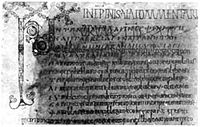
Bobbio Jerome
Encyclopedia

Manuscript
A manuscript or handwrite is written information that has been manually created by someone or some people, such as a hand-written letter, as opposed to being printed or reproduced some other way...
copy of the Commentary on Isaiah attributed to St. Jerome
Jerome
Saint Jerome was a Roman Christian priest, confessor, theologian and historian, and who became a Doctor of the Church. He was the son of Eusebius, of the city of Stridon, which was on the border of Dalmatia and Pannonia...
. The manuscript has 156 pages and measures 235 by 215 mm. It is a palimpsest
Palimpsest
A palimpsest is a manuscript page from a scroll or book from which the text has been scraped off and which can be used again. The word "palimpsest" comes through Latin palimpsēstus from Ancient Greek παλίμψηστος originally compounded from πάλιν and ψάω literally meaning “scraped...
that previously contained a sixth century copy of the Gothic
Gothic language
Gothic is an extinct Germanic language that was spoken by the Goths. It is known primarily from the Codex Argenteus, a 6th-century copy of a 4th-century Bible translation, and is the only East Germanic language with a sizable Text corpus...
translation of the Bible
Bible
The Bible refers to any one of the collections of the primary religious texts of Judaism and Christianity. There is no common version of the Bible, as the individual books , their contents and their order vary among denominations...
by Ulfilas
Ulfilas
Ulfilas, or Gothic Wulfila , bishop, missionary, and Bible translator, was a Goth or half-Goth and half-Greek from Cappadocia who had spent time inside the Roman Empire at the peak of the Arian controversy. Ulfilas was ordained a bishop by Eusebius of Nicomedia and returned to his people to work...
written in Gothic uncial
Uncial
Uncial is a majuscule script commonly used from the 3rd to 8th centuries AD by Latin and Greek scribes. Uncial letters are written in either Greek, Latin, or Gothic.-Development:...
, with Rustic capitals
Rustic capitals
Rustic capitals is an ancient Roman calligraphic script. As the term is negatively connotated supposing an opposition to the more 'civilized' form of the Roman square capitals Bernhard Bischoff prefers to call the script canonized capitals.Rustic capitals are similar to Roman square capitals, but...
as a display script.
The illumination of the manuscript consists of a large initial N on page two of the manuscript and several other minor initials. The N is as large as nine lines of the main text. It is written in black ink and decorated by whorl and cross patterns and pelta motifs. There are touches of green and orange. The cross bar is formed, in part, by two fish bent to form an S curve. The form of the N is comparable to the initial INI monogram of the opening illumination of the Gospel of Mark
Gospel of Mark
The Gospel According to Mark , commonly shortened to the Gospel of Mark or simply Mark, is the second book of the New Testament. This canonical account of the life of Jesus of Nazareth is one of the three synoptic gospels. It was thought to be an epitome, which accounts for its place as the second...
found in a fragmentary Gospel Book from Durham Cathedral.
On page two there is an inscription connecting the manuscript to Atalanus, who was St. Columbanus
Columbanus
Columbanus was an Irish missionary notable for founding a number of monasteries on the European continent from around 590 in the Frankish and Lombard kingdoms, most notably Luxeuil and Bobbio , and stands as an exemplar of Irish missionary activity in early medieval Europe.He spread among the...
's successor as abbot of the monastery at Bobbio
Bobbio Abbey
Bobbio Abbey is a monastery founded by Irish Saint Columbanus in 614, around which later grew up the town of Bobbio, in the province of Piacenza, Emilia-Romagna, Italy. It is dedicated to Saint Columbanus...
. Atalanus died in 622. If this inscription is accepted as authentic, then this manuscript was produced before 622, making its initial N one of the earliest Insular
Insular art
Insular art, also known as Hiberno-Saxon art, is the style of art produced in the post-Roman history of Ireland and Great Britain. The term derives from insula, the Latin term for "island"; in this period Britain and Ireland shared a largely common style different from that of the rest of Europe...
style initials, preceding even the Cathach of St. Columba
Cathach of St. Columba
The Cathach of St. Columba is an late 6th century Irish Psalter.It is traditionally associated with St. Columba , and was identified as the copy made by him of a book loaned to him by St. Finnian, and which led to the Battle of Cúl Dreimhne in 561...
.
It is interesting to compare this initial with the few decorated ones in Gregory the Great, Pastoral Care (Troyes, Bibliothèque Municipale, MS 504), from Rome, and about twenty years older.

